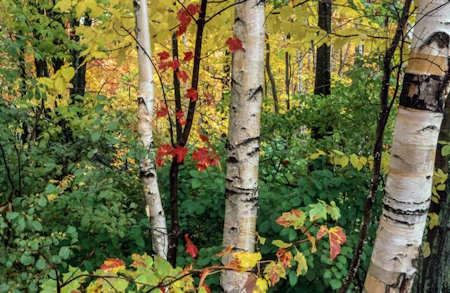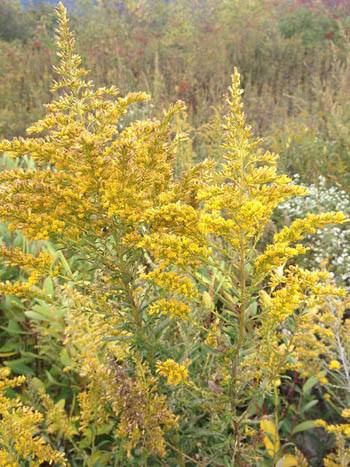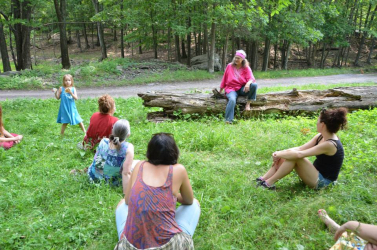
Trees are some of the most fascinating of all plants and of all herbal medicines. The lore surrounding any one type of tree – even some individual trees – is vast.
Consider doing a brief meditation with each tree, breathing with it, listening to it, and being open to the messages that it has to share with us. Every breath is a give away dance of joy.
BIRCH is the tree of beginnings. Birch (Beth) begins the ogam alphabet. Birch was the first tree to take hold in Europe as the glaciers retreated after the last ice age. Birch is one of the first trees to grow in disturbed soils. A birch tree in your dream is a strong indication that you are beginning a new aspect of your life, and that new spiritual understandings await you.
Birch is Betula to the botanist. In Sanskrit, it is burgha, meaning "that which is good to write upon." The use of birch bark as a material to write upon is thought to predate paper, and even to be the model for papermaking. Magic spells are often written on a piece of birch bark.
Birch is the "way shower." Birch is safety and warmth in the cold. Birch is the sky ladder of the Siberian shaman. Birch is the cradle for the newborn. Birch twigs are used to whip the skin in Scandinavian saunas; a kind of rebirth. Birch twigs are used to light the sacred fires in Wales. Birch torches were used to "purify" the land, to expel "evil spirits" and maleficent fairies, and to "beat the boundaries" at winter solstice throughout old Europe.
Birch bark will burn whether wet or dry. This knowledge has saved my life at least once in high mountains when hypothermia threatened. Birch bark is antiseptic. Because it is pliable when fresh, it may be fashioned into containers which preserve food. Strangely enough, a simple birch bark cup can be use over an open fire to boil water without bursting into flames.
There are many Native American stories in which birch saves the. The European fairy tale we know as Cinderella is based on an older Russian story in which a woman becomes a birch tree in order to take care of her orphaned daughter. (Some versions say it was a beech tree. Walt But the original tale centered on the caring love of the birch. Disney left out the tree, alas.)
Notice that the wood of birch rots away quickly while the bark remains intact, often in one piece, for many years. Birch bark canoes are justly famous.
Birch leaves – collected in the spring only – can be used to make a tea which eases sore throats, bleeding gums, sores in the mouth, constipation, gout, rheumatism, kidney stones, and bladder problems. The tea has a slightly sedative effect and eases sore muscles, too.
Older birch leaves can be added to a hot bath or made into a strong brew and poured into the tub to heal moist, oozing skin conditions.
Recent studies have found an anticancer compound in birch sap: betulinic acid. Older herbals contain recipes for birch beer made by fermenting the sap; and for birch vinegar, also made by fermentation. I have never tapped a birch tree as they don't heal easily and can bleed to death. The sweet birch that I use to demonstrate on in the spring often drips sap for several days after I break a small limb.
Sweet birch is my favorite of the birches. It smells of wintergreen and is used commercially to produce essential oil of wintergreen. A hot water infusion of the twigs gathered before they leaf out is all I use as a household cleanser. A handful of twigs in a quart jar may be rebrewed up to thirty times before they need to be replaced. This cleanser is safe for children to drink, but effectively loosens and removes grease and grime.
Birch wood is primarily used as a veneer. It is light in weight and light in color. It is favored in the manufacture of electric guitars.
Who can fail to be moved by the mystery of a white-barked birch shining under the light of the full moon on a snowy winter night?

I love autumn; don't you? The days shorten and fall colors thrill my senses. Perennial roots get busy storing nourishment that will last them through the winter. And the meadows bloom with purple asters and riotous goldenrod flowers.
Goldenrod (the Solidago genus, Asteracea family) is one of my favorite plants, and hopefully, soon it will be one of your favorites too.
Before you complain that goldenrod is a pest and you're allergic to it, let me set the record straight: You aren't. No one is, no one can be, allergic to goldenrod pollen. Why? It has virtually none. What little pollen it makes is sticky, all the better to stick onto insects who pollinate the goldenrod. Only wind-pollinated plants -- like ragweed (Ambrosia artemisifolia), which blooms at the same time as goldenrod, and has an especially irritating pollen -- make enough pollen, and spread it widely enough, to cause allergic reactions.
Set aside your mistaken bad thoughts about lovely goldenrod, and, if you can, visit a patch. Goldenrod is a wide-spread wild plant in North America (found from Florida to New Hampshire and west into Texas), Europe, and Asia. Goldenrod is also treasured as a garden plant from New Zealand to Germany, and has become a highly-successful weed in Japan. So, no matter where you live as you read this article, it is likely that you can find a patch of goldenrod.
It is rare to see one goldenrod plant growing alone; it multiplies by sending out root runners, so there are usually dozens of plants growing densely together. Notice all the bees and insects happily crawling about on goldenrod's numerous small yellow flowers.
There are many types of goldenrod, and you are likely to find several kinds if you look around. The species Solidago canadensis and S. odora are considered the most medicinal (and the tastiest), but all species of goldenrod are safe and beneficial and can be used to help the immune system get ready for winter.
Goldenrod tonics are easy to make. Harvest any goldenrod by cutting the top third of the plant in full flower on a sunny fall day. Or, respectfully pull the entire plant, roots and all, in the late autumn or early winter. Then follow the simple directions below. Note: You can use any size jar when making a vinegar or a tincture, so long as you fill it full.
To dry flowering goldenrod: Bundle 2-3 stalks together and hang upside down in a cool, shady room until thoroughly dry. When the stalks snap crisply, store the dried herb in brown paper bags. One or two large handfuls of crushed leaves and flowers, steeped in a quart of boiling water for thirty minutes makes a tea that can be used hot, with honey, to counter allergies (especially pollen allergies), fevers, sore throats, coughs, colds and the flu; or taken cold to relieve colic in babies, and gas in adults. Dried mint and/or yarrow are tasty, and useful, additions when making goldenrod flower tea.
To dry goldenrod roots: Rinse dirt off the roots, then cut away all th estalks, leaves and dead flowers. If possible, hang your roots over a woodstove to dry; if not, place them on racks and put them in a warm place to dry until brittle. Store in glass jars. Depending on the difficulty you are addressing, goldenrod root tea may be made with large or small amounts of the roots brewed or decocted in boiling water. Or the roots may be powdered, alone or mixed with flowers, and applied to hard-to-heal wounds and sore joints.
To make a goldenrod vinegar: Chop the goldenrod coarsely, filling a jar with chopped flowers, leaves, stalks (and roots if you have them); then fill the jar to the top with room-temperature, pasteurized, apple cider vinegar. Cap it tightly with a plastic lid. (Metal lids will be eroded by the action of the vinegar. If you must use one, protect it with several layers of plastic between it and the vinegar.) Be sure to label your vinegar with the date and contents. Your goldenrod vinegar will be ready to use in six weeks to improve mineral balance, help prevent kidney stones, eliminate flatulance, and improve immune functioning.
To make a goldenrod tincture: Chop the goldenrod coarsely, filling a jar with chopped flowers, leaves, stalks (and roots if you have them); then add 100 proof vodka, filling the jar to the very top. Cap tightly and label. Your goldenrod tincture will be ready to use in six weeks, by the dropperful, as an anti-inflammatory, a sweat-inducing cold cure, and an astringent digestive aid. Medical herbalists use large doses (up to 4 dropperfuls at a time) of goldenrod tincture several times daily to treat kidney problems -- including nephritis, hemorrhage, kidney stones, and inability to void -- and prostate problems, including frequent urination.
The colonists called goldenrod tea "Liberty Tea," for they drank it instead of black tea after the Boston Tea Party. In fact, Liberty Tea proved so popular, it was exported to China! Let goldenrod liberate you, too. Herbal medicine is people's medicine, a gift from Mama Earth to us.
Green Blessings.

 The Wise Woman Center exists to re-weave the healing cloak of the Ancients. This land is sacred, it is a safe space for women, and a place for the teachings of the Wise Woman way. The Goddess lives here, as do goats, fairies, green witches, and elders.
The Wise Woman Center exists to re-weave the healing cloak of the Ancients. This land is sacred, it is a safe space for women, and a place for the teachings of the Wise Woman way. The Goddess lives here, as do goats, fairies, green witches, and elders.


